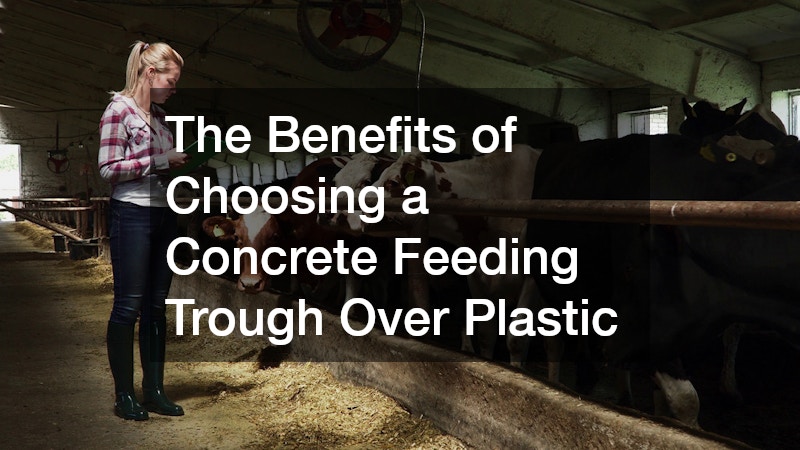Feeding livestock efficiently and hygienically is a top priority for farmers and station managers across Australia. When it comes to selecting the right tool for the job, the material choice matters more than most realise. While plastic options may be common, more farmers are turning to a strong feeding trough for long-term reliability, durability and livestock health benefits.
In this article, we explore the key advantages of choosing a concrete feeding trough over plastic, from environmental considerations to performance in the Australian climate.
Built to Withstand Harsh Australian Conditions
Australia’s climate is notoriously tough. From blistering heat waves in the Outback to freezing mornings in the southern regions, farming equipment must endure a wide range of environmental stressors.
This is where a cement feeding trough shines. Unlike plastic alternatives that can warp, crack or fade under intense UV exposure, concrete retains its structural integrity regardless of temperature extremes.
Concrete troughs are solid, heavy and not prone to movement, even during strong winds or when stock push against them. This provides peace of mind for farmers, reducing the risk of damage and the need for constant repositioning or maintenance. For properties in remote locations, this means fewer trips for repairs and replacements, saving both time and money.
Improved Durability & Longevity
One of the primary reasons farmers are making the switch is the long-term value. Concrete troughs have a lifespan that far exceeds plastic options. While plastic troughs may be cheaper initially, they are far more likely to degrade, become brittle or puncture over time, especially when exposed to livestock hooves or horns.
Concrete is highly resistant to impact and wear, making it ideal for busy paddocks or yards where multiple animals feed at once. It’s not uncommon for a quality concrete feeding trough to last for decades, proving to be a more cost-effective choice in the long run.
Additionally, because of their sturdiness, concrete troughs don’t tip easily. This reduces the risk of water or feed spills, which in turn minimises waste and ensures stock receive consistent access to nourishment. Less spillage also keeps the surrounding ground drier and cleaner, contributing to better animal welfare.
Better for Livestock Health & Safety
Animal welfare is a growing concern in modern agriculture, and the type of feeding equipment used plays a role. Concrete has a smoother finish than many plastic troughs, which often develop sharp edges or cracks as they age. These imperfections can cause cuts or abrasions to the mouths and noses of feeding animals.
A cement feeding trough offers a safer, more hygienic feeding environment. Concrete doesn’t harbour bacteria as easily as scratched plastic surfaces might. This makes it easier to clean and maintain, reducing the risk of disease transmission among animals. Proper hygiene in feeding practices leads to healthier livestock, which translates into higher productivity and fewer vet bills.
Environmentally Sustainable Option
Choosing sustainable farming materials is becoming increasingly important for Australian landholders. Concrete is often viewed as a more environmentally friendly option in this context, especially when it is locally sourced and produced.
Unlike plastic troughs, which are petroleum-based and can break down into microplastics over time, concrete does not contribute to long-term pollution. At the end of its lifecycle, a concrete trough can be crushed and recycled as aggregate, making it a less wasteful solution.
For eco-conscious farmers, investing in a solid feeding trough supports sustainable land management and reflects a commitment to environmentally responsible agriculture.
Lower Long-Term Costs & Maintenance
While concrete troughs may have a higher upfront cost, their strength and resilience translate into fewer replacements and repairs. This makes budgeting easier and more predictable for farmers over the years.
Plastic troughs often require patching or full replacement, particularly when exposed to cattle or larger stock. Concrete, by contrast, typically needs little more than occasional cleaning and monitoring for surface wear. The cost savings from reduced downtime, fewer purchases and minimal repairs can be significant over the life of a farm.
Moreover, cement feeding troughs can be custom-moulded to suit different farm layouts or stock needs. Whether for sheep, cattle or mixed herds, concrete manufacturers offer tailored designs that improve feeding efficiency and livestock access.
A Smarter Investment for Australian Farms
Choosing the right feeding equipment is an important decision that affects both operational efficiency and animal welfare. For Australian farmers facing tough conditions and seeking long-term solutions, concrete feeding troughs offer clear advantages over plastic alternatives.
With their superior durability, environmental benefits, animal safety and cost-effectiveness, concrete troughs represent a practical and forward-thinking choice. In the long run, they’re not just an investment in infrastructure—they’re an investment in the future of the farm itself.



